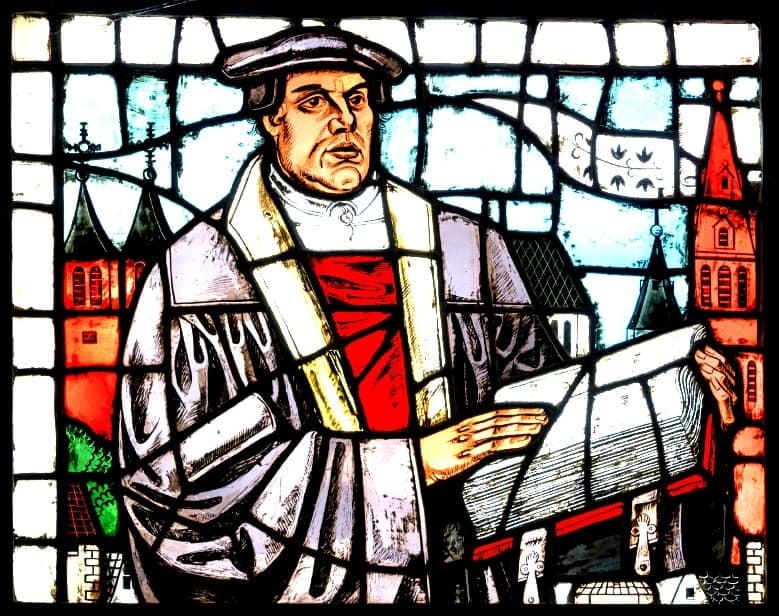
Why don’t we conduct our church services in Latin and pretend to buy our way into Heaven and pray to saints and call ourselves Catholic? As Protestants of any denomination (or even as Catholics!), we owe a lot to Martin Luther and his daring acts of reform. We often do not take the time to study much of our founding fathers (and mothers) of faith, but examining church history can educate, encourage, and inspire our efforts as people of God. This lesson peeks at the life and contributions of Martin Luther, author of the Protestant Reformation.
Lesson focus: Martin Luther challenged a lot of things that people were doing wrong; sometimes it is okay to go against people in charge if it means following God.
Passage: “For it is by grace you have been saved, through faith— and this not from yourselves, it is the gift of God— not by works, so that no one can boast.” Ephesians 2:8-9
Target Audience: Pre-k through fifth grade (adaptable)
Materials Needed: Candy (candy corn/small things) or crackers; pictures of Martin Luther and Germany map; paper towel rolls; paper and pencils; gummi worms.
Lesson Opening: Start with a little illustration of the silly nature of “indulgences…” provide each student with a handful of candy corn, but then inform them they are not to eat it right away. Start going through a list of potential offenses, and with each one have students hand over a piece if they have done it…has anyone ever told a lie or fib? Been disrespectful? Misspelled a word? Been unkind to a sibling? With each deed, remove another candy. Does that seem fair? If the candy was a gift, should we have to earn it and deserve it? Explain that people used to think of God’s love and forgiveness as something that had to be earned. They thought if you worked or prayed or payed hard enough you could get God’s love. Fortunately, we know better now, and a lot of that is thanks to a man who protested the old church: Martin Luther.
Bible Lesson:
This lesson takes place with some interactive elements as it goes through the stages of Luther’s life. Feel free to follow along or adapt as best suits the group.
-Martin Luther started out on the path to becoming a lawyer. One day he got caught in a bad rain storm and begged God to save him, promising he would become a monk.
-Luther worked hard at the monastery. He often made himself feel very guilty about his life, and would spend hours praying and repenting. Have students kneel and get up several times. If possible, play some choral or monk-ish background music.
–Martin went away to school and earned his doctorate degree. He studied theology and the Bible and realized that a lot of the things the church was doing were wrong.
-Luther decided he needed to tell people about God’s grace and how the church wasn’t doing what it should. He wrote a series of statements about what was going on and what he believed. Allow students to decorate and wrinkle up the paper for their paper towel tube “scroll” and attach to tubes. His writings had to do with what he didn’t like about the Catholic practices. He also posed five “solas”– things of utmost importance. What were these?
1.) “Sola Scriptura” (Scripture Alone: 2 Timothy 3:16-17)
2.) “Sola Gratia” (Grace Alone: Ephesians 2:8-9)
3.) “Sola Fide” (Faith Alone: Galatians 3:11)
4.) “Solus Christus” (Christ Alone: 1 Timothy 2:5)
5.) “Soli Deo Gloria” (To God Alone Be Glory: 1Peter 4:11).
–Luther continued to tell people about God’s grace and stir things up with his statements. However, the church leaders of the time were not too pleased with that. Hmmm…Who else do we know that didn’t get along well with church leaders of the time?? (Jesus!)
-In 1521 (four years after his theses), Luther was brought to be questioned by the Diet of Worms and challenged to take back his statements. Pass out gummy or rubber worms, if desired.
-Luther affirmed what he had already said about grace and God, and refused to take his statements back. This certainly did not win any support from those in charge! In fact, they basically made him a convict and put a ban on his writings.
-Martin Luther had a friend who helped him escape by taking him away to a castle in Wartburg Germany. He hid there for almost a year. If possible, take a quick walk around the room and “hide” under a table or wherever possible.
–While hidden away, Martin Luther translated the Bible so people could read it. Hold up (or pass around) a paper with some Latin writing. Who can read that or understand it? Back in Luther’s time, people believed only certain priests should be allowed to read the Bible, and no one had it in their language. Luther made the Bible available to regular people, too!
-Later on, Luther married a former nun and went on to have several (six!) children. He wrote many important things, including the church catechism and several hymns. He died in 1546.
So why does this matter? If not for the Protestant Reformation, many people would likely not have the opportunity to practice their faith as they do today. And after all, we are called Lutherans… J
Craft:
Have students finish up the “scrolls” by writing (older students) sentences about what they believe, or drawing a picture. Attach the pictures to the paper towel tubes.
Close with prayer and thank God for all He has given. Remember to pass out parent notes, verse of the week, and prizes for any who remembered last week’s verse. J
Additional activities to celebrate Luther:
- Develop an obstacle course and play “rescue Luther” by running through the course to capture and re-place an object representing Martin Luther. Hide him in a “Wartburg Castle.”
- Enjoy a tasty snack “worm diet” with pudding and gummi worms!
- Play “pin the theses on the door” a la pin the tail on the donkey…cut printed copies of the original statements into strips and blindfold students and help them attach the strips to a pole or door representing Wittenberg.
- Play “toss the papal bull,” using scrolled papers and tossing into a bucket or other target.
- Color a Luther rose or stained glass-style window.

I am disturbed about the “downing” of other walks of faith. Martin Lurherfid NOT intend to leave the Church and was wanting to meet with church officials only.
You maybe interested in other ‘truths’ of mr. Luther.
-he believed in the Real Presence of Christ in the Eucharist
-did not believe in free will
-he added the word ‘alone’ to Romans 3:28
-he believe in Mary’s perpetual virginity
-l if you believe in ‘SolaScriptura’, you deny some key verses: 2 Thessalonians 2:15 & John 21:25 & 2 Timothy 1:5. Just to name a few
Lastly,
What truth do you teach when you have to go it by falsely accusing and trying to tear down teaching straight from Christ the Aposles, and the early church
Much disappointment; as of this date I am unsubscribing to your website
I am a Roman Catholic catechist who has enjoyed this website for many years. I am extremely offended by this post. I believe it to be mean spirited and certainly out of keeping of effort at ecumenical dialogue. You should know that following 50 years of national and international dialogue, Lutherans and Catholics have together issued “Declaration on the Way: Church, Ministry and Eucharist”. This document is intended to mark a pathway to greater visible unity between Catholics and Lutherans. Your post makes a mockery of that good work. Kindly remove my name from this website. Cathy Owens
I want to apologize for any interpretations that this lesson is an attempt to “bash” or put down other denominations or walks of faith. That most certainly was NOT the goal of this article. This is but a brief glimpse at the life and work of an early church father. It is not to say that modern Catholicism is errant in any way or even that early church leaders were somehow evil. This lesson is not meant to declare Martin Luther a saint or to claim that his teachings are gospel to be followed. It is merely a biography synopsis and celebration of someone who did a great deal for early church movements and Biblical translation efforts. I do hope that it is not taken as anything more serious, and am sorry if it is.
To be fair, many Roman Catholics also believe the protest movements by Martin Luther and others was helpful because the church in that day had lost it’s direction — specifically with in the matter of salvation by faith.
Thank you for the fun ways to teach about Martin Luther.